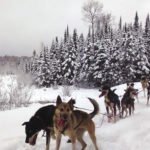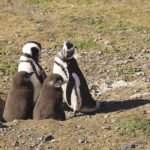For Chris Dube, a 13-year resident of Terrace Bay, Ontario, the fall and winter winds mean high time for freshwater surfing.
“I’ve never felt a deeper connection to the land and the lake than when I’m in the water,” says Chris. “Everybody has this idea that nature is like this sunny day. But here’s this beautiful moment where you’re getting blasted by the wind…and you’re playing with one of the most powerful—if not one of the biggest—lakes on earth. The granite hills, the boreal forest, fresh water. It’s a magical time of year, these transitional seasons between winter and summer. It’s never lost on me just how beautiful it is and how lucky we are.”
The zeal in Chris’ voice is echoed by the fact that he’s a high school teacher and a passionate ambassador for the outdoors. He loves to move and he loves to bring people together. Only minutes into our interview it’s easy to tell why he hosted Waasaashkaa: A Gathering of the Great Lakes Surfers in his tiny North Shore community over a weekend last October.
Waasaashkaa translates to the lake has white caps in Ojibwe.
“I wanted something that basically spoke to the heritage of the land, the traditions, talking about the Indigenous people…something that encompassed all of that,” he said.
2017 was the inaugural year for the event, born out of a simple desire to bring the “old school” surfers back together and out of their busy day-to-day lives, and to give anyone who’s been skirting the idea of surfing a chance to get on a board and feel confident enough to try it out. Co-organizer Jaakko Natri of Natribros Surf & SUPerior Standup Paddleboards provided rental gear through the weekend.
“Obviously I wanted to promote the scene. How do you create any scene in these northern Ontario communities? We’re relatively isolated. Whether it’s ice climbing, rock climbing, surfing, kayaking, canoeing…someone brought me out and taught me how to ice climb. I didn’t learn any of that myself, and that’s what I feel like northern Ontario is…I understand it’s different in different places, but that’s my vision for what our scene should be,” said Chris.
On day one of the gathering, surfers started filing into Terrace Bay from as far away as Duluth and Winnipeg, Manitoba, where the standup paddleboarding scene is strong.
“I call it the love and stoke,” he tells me, describing the scene on his front lawn that day. “It’s nine or ten in the morning, everybody’s drinking their coffee, everyone’s waxing their boards… People are rolling into town and pulling into my driveway. There’s like 40 cars on the road and surf boards all over the place—I’ve never seen anything like it. Usually it’s like me and the eagles and a few people.”
I assumed that surfing was simply left to the oceans, rooted in the history and traditions of coastal cultures around the tropics. The fact is that Chris and his friends represent a subculture of wave riders along the North Shore that join larger groups of surfers in communities around the Great Lakes.
“It’s hard to say where Great Lakes surfing started,” says Brian Tanis, publisher of Great Lakes Surfer’s Journal based out of Ann Arbor, MI, an annual publication that celebrates Great Lakes surf, culture and community. “We did a feature on 90-year-old ‘Doc’ Seibold, who started surfing the lakes in 1955 in Grand Haven, MI. He may have been the first one but what we’ve found [is] there were people entertaining the idea around the lakes independently. In that spirit, although there is no hard proof, it stands to reason that natives would have most likely recognized the power of the wave and were appropriately opportunistic. I mean, if you’re canoeing the lakes downwind, it’s simply logical to use all of your energy resources for propulsion, including waves, and that would technically qualify as surfing.”
The photo on the cover of the first edition of GLSJ features a surfer in a Neoprene wetsuit smiling with icicles stemming from his moustache and the brim of his hood. Not my cup of tea, but this guy looks genuinely elated. So what’s it like to surf a Great Lake? After some careful thought, Chris singles out one word: challenging.
“There are a few things to take into account for Great Lakes surfing,” he cautions.
Because freshwater surfing depends on waves generated from sustained onshore winds, they come in at tighter intervals than offshore ocean waves.
“So you literally sometimes only have four or five seconds after you’ve been dumped by one wave to get back on your board, paddle-paddle-paddle, then you get dumped, and paddle-paddle-paddle…it’s a lot of work getting yourself into position. Then you have your wet suit, which adds weight.”
Freshwater is also denser than saltwater and less buoyant.
“Between the water temperature, the frequency of the wave patterns, the wind-generated waves, all of those sorts of things—it’s challenging. And then maybe you have snow in your face,” he adds.
But don’t let that turn you off. There were some “beautiful moments” at Waasaashkaa, says Chris, not only because the bigger waves eventually rolled in to give more seasoned surfers something to play with; the south winds generated three- to five-foot waves that were perfect for beginners, all under fairweather skies followed by a potluck dinner at his house.
“For me it was one of my proudest days, seeing something like that come together, to see people partake in something that they were so interested in…you have that personal growth and the human connection,” he says. “You don’t have these moments all the time, and so when they occur you really have to relish them.”




